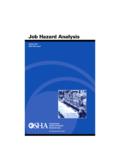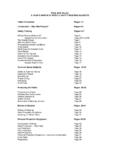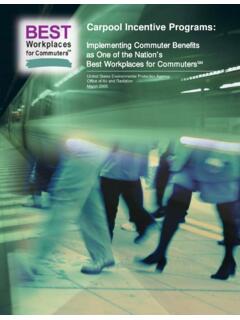Transcription of A guide to rapid assessment of human resources …
1 English only A guide to rapid assessment of human resources for health world health organization Geneva 2004 A guide to rapid assessment of human resources for health world health organization 2004 All rights reserved. Publications of the world health organization can be obtained from Marketing and Dissemination, world health organization , 20 Avenue Appia, 1211 Geneva 27, Switzerland (tel: +41 22 791 2476; fax: +41 22 791 4857; email: Requests for permission to reproduce or translate WHO publications whether for sale or for noncommercial distribution should be addressed to Publications, at the above address (fax: +41 22 791 4806; email: The designations employed and the presentation of the material in this publication do not imply the expression of any opinion whatsoever on the part of the world health organization concerning the legal status of any country, territory, city or area or of its authorities, or concerning the delimitation of its frontiers or boundaries.))
2 Dotted lines on maps represent approximate border lines for which there may not yet be full agreement. The mention of specific companies or of certain manufacturers products does not imply that they are endorsed or recommended by the world health organization in preference to others of a similar nature that are not mentioned. Errors and omissions excepted, the names of proprietary products are distinguished by initial capital letters. The world health organization does not warrant that the information contained in this publication is complete and correct and shall not be liable for any damages incurred as a result of its use. Contents HRH conceptual HRH About this Main issues and HRH main Basic documents/instruments for in-depth assessment of Policy and Labour market Education and Priority health Country Monitoring and A guide to rapid assessment of human resources for health The world health organization , through its Department of human resources for health (HRH) works with Member States to strengthen their capacity to educate, plan and manage their health workforce so that health services can meet health needs.
3 The Department fosters HRH policies within each country's health policies in the context of the country's overall development policies. This involves forging a global consensus on HRH, by means of pursuing in-depth work in countries and building networks. The Department has developed tools to analyse and address the various HRH issues to better assist countries. These tools lay out a general framework built in collaboration with partners, including staff of ministries of health , health training institutions, professional associations and bilateral and international partners. HRH conceptual framework Non- health health - Financing -Stewardship/ health planning-Provision- resource generation Market failuresStakeholdersRegulationsTime lagPotential market powerUtilization of health careEducation/trainingLabour participationMigration health Care SystemHealth Labour DemandHealth Labour SupplySocio-demographic EconomicShortageEquilibriumOversupplyFin ancial /Physical/KnowledgeResourcesPoliciesCult uralGeographical This framework points out the importance of placing health workforce issues in a broad perspective that takes into account the influence of globalization and national and subnational factors.
4 It includes cultural as well as political, sociodemographic, economic and geographical factors in health workforce issues. It is based on the premise that population health should drive the planning, actions and management of the health system. It emphasizes the importance of linking HRH with outcomes of the health system. To translate this framework into a practical and operational tool for countries to use, the Department has developed a template of perspectives through which HRH should be assessed at the country level. This HRH lens cuts across the main HRH issues such as policy, education, recruitment and retention, migration, incentives and the various initiatives, mechanisms and developmental policies and plans being conducted at the country level such as MTEF, PRSP, SWAps1 and priority health programmes (including HIV/AIDS, TB and malaria).
5 1 MTEF: Medium-Term Expenditure Framework; PRSP: Poverty Reduction Strategy Paper; SWAps: Sector-Wide Approaches. 6 Interventions and process HRH policy health labour market Education/ training RecruitmentRetentionMigrationIncentivesR egulationDistribution/equity Development plan PRSP MTEF Public sector reform Civil service reform SWAps health investment plan (CMH) health policy health information system Child survival MPR HIV/AIDS Malaria TB Other HRH lens About this guide This rapid - assessment guide is designed to help users arrive at a global overview of a country's HRH situation.
6 It addresses only issues generally recognized as major challenges for most countries. It is intended to be user-friendly and applicable quickly: the data collection and analysis should not last more than four weeks. It will combine both quantitative and qualitative information and methods. It is neither a data-collection instrument nor a step-by-step guide to data analysis. Each section specifies the type of information to be elicited and why. Included is a list of tools and sources of additional information for in-depth analysis of specific HRH issues. The guide is designed to help users assess current HRH constraints and challenges to "scaling up" health interventions.
7 Users include: health policy-makers planners national and local health managers those responsible for monitoring and evaluation researchers professional associations regulatory bodies training institutions and donors consultants in the preceding areas. Not all the indicators and answers may be available or even necessary for a given country situation. But the issues and dimensions that follow show what kinds of information can be assembled regularly to track developments affecting human resources for health . Main issues and dimensions HRH main issues 1. Policy, regulation and planning 2. Management and performance improvement 3.
8 Labour market 4. Education, training and research 5. HRH and priority health programmes 6. Monitoring and evaluation Dimensions 1. Policy, regulation and planning Policy Legislation and regulation Planning Financing Stakeholders 82. Management and performance improvement Motivation/incentives Recruitment/retention Imbalances in deployment and equity Migration Supervision, leadership and performance assessment Job description Working conditions 3. Labour market Employment/employers Wages/salaries Workload Sector of work (public/private) Unions/ghost workers 4. Education, training and research health professions educational institutions health training programmes and institutions Educational staff Number of entrants and graduates Continuous education Research on HRH 5.
9 HRH and priority health programmes HIV/AIDS TB Malaria Reproductive health /IMCI Other national or regional priority programmes 6. Monitoring and evaluation Information/data availability Staffing numbers Uses of the information Monitoring methods Sources 9 Questions This section proposes crucial questions for each of the issues and dimensions. Policy, regulation and planning Dimension Questions Policy Q1. Is there a national health policy (or equivalent)? Briefly describe it, including the building process, content, last update and other relevant issues.
10 Q2. Does the country have an HRH policy (or equivalent)? Is it written down? Q3. Is HRH acknowledged in broader development policies (PRSP, MEFF, etc.)? Q4. Are there HRH policies at each level, from national to local ( a decentralized HRH policy)? Q5. Are there strategies to ensure that the most vulnerable populations receive services? Planning Q1. Does the country have a strategy or plan for HRH? Is it periodically updated? Does it include staffing targets? Q2. Does the existing staff correspond to the target staffing levels? Q3. What tools/methods of planning are used in the country (WHO's Workload Indicators for Staffing Needs, etc.)? Q4. Does the country have an HRH planning or management unit within the MoH?















